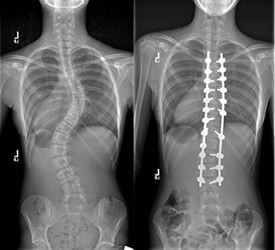The Bent Spine
Drs SR Maharajh, J Shaik & KD Sood
In Part I of our article on scoliosis, it was mentioned that the cause of scoliosis is often unknown (idiopathic). In Part II, we highlight the risk factors associated with scoliosis, as well as the effects that it has on the individual and the different treatment options that are available.
What are the risk factors associated with scoliosis?
- Age: Young individuals, especially adolescents, are at risk of developing scoliosis during the growth spurt which occurs just before puberty. Scoliosis in the elderly may be due to advanced spinal degeneration (spondylosis)
- Gender: Females have a higher risk of developing a scoliosis. The may be due to the effects of the hormone leptin on the nervous and musculoskeletal systems.
- Genetics: One is more likely to develop scoliosis if one’s blood relatives (e.g. parents) already have scoliosis.
- Poor posture: Poor spinal posture contributes to the development of scoliosis
What are the symptoms/effects of scoliosis?
- A bulge on one side of the (back of the) chest (known as the rib hump)
- Shortness of breath and chest pain as a result of compression of one side of the chest.
- Impaired function of the heart or lungs in severe cases, if left untreated.
- Chronic back pain and pain in the hips and knees.
- Psychological – anxiety or depression as individuals become concerned about their appearance.
- Interestingly, one study found that right thoracic and double curves in girls and right lumbar in boys were significant factors for curve progression.
How is scoliosis treated?
In mild types of scoliosis, and functional scoliosis, muscle rehabilitation and postural correction can be used to correct the curvature. Chiropractic treatment including spinal manipulation can be helpful in alleviating pain and stimulating the appropriate muscles of the spine. In severe idiopathic scoliosis, more aggressive forms of treatment are indicated. These include bracing of the spine, which holds the spine in a straight position, and has been shown in some studies to prevent worsening of the curve (an example is shown in Figure 1). In some severe cases, where the progression of the curve cannot be prevented using braces, surgery may be indicated. This is decided by the spine surgeon after thoroughly assessing the spine. The surgery involves the use of screws and rods to correct the curve of the spine (Figure 2). In adolescents, the rods are lengthened every 6 months in order to allow proper correction over time as normal growth occurs.

Figure 1: An example of a brace for scoliosis treatment

Figure 2: An x-ray showing pre- and post-surgical correction of a severe scoliosis
At KZN Spine Care, we are committed to helping you achieve optimal spine and musculoskeletal health. We welcome your comments and queries. We will answer some of your questions in a series of short videos. For further advice or if you need consultation please contact:
Dr KD Sood: 031 207 5252 (ext. 6) or 083 557 7949 (Sydenham/Overport)
Dr J Shaik: 032 541 6028 or 031 207 5252 (ext. 6) (Verulam and Sydenham/Overport)
Dr SR Maharajh: 084 888 8308 (Greyville)
